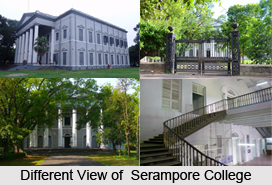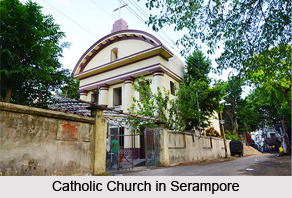 Monuments in Serampore bears some of the architectural works of the British which still exist to narrate the heydays of their time. Located at a distance of about twenty one kilometers to the north of Kolkata, Serampore used to be the former Danish settlement of Fredricksnagar. Founded in the year 1755 by the Danish East India Company, the town was captured by the British in the year 1801, but then restored to the Danes by the Treaty of Amiens on the 27th of March 1802. In the year 1808, it was captured once more, then returned again in 1815, at which time it had begun to silt up and ceased to have much maritime use. In the year 1845, the Danes sold their Indian possessions; Tranquebar, Fredricksnagar and few portions at Balasore, to the British for one hundred and twenty five thousand pounds.
Monuments in Serampore bears some of the architectural works of the British which still exist to narrate the heydays of their time. Located at a distance of about twenty one kilometers to the north of Kolkata, Serampore used to be the former Danish settlement of Fredricksnagar. Founded in the year 1755 by the Danish East India Company, the town was captured by the British in the year 1801, but then restored to the Danes by the Treaty of Amiens on the 27th of March 1802. In the year 1808, it was captured once more, then returned again in 1815, at which time it had begun to silt up and ceased to have much maritime use. In the year 1845, the Danes sold their Indian possessions; Tranquebar, Fredricksnagar and few portions at Balasore, to the British for one hundred and twenty five thousand pounds.
Serampore, also known as Srirampur or Serampur, is a city and a municipality in the Hooghly district in the Indian state of West Bengal. It is also a part of the area covered by Kolkata Metropolitan Development Authority. Serampore is a pre-colonial town on the right bank of the Hooghly River and was part of Danish East India Company under the name Frederiksnagore from 1755 to 1845. Later Serampore became renowned for the work of the three Baptist missionaries; William Carey, William Ward and Joshua Marshman, who resided in the Danish port to avoid the hostility of the English authorities in Kolkata.
 Serampore College faces Barrackpur Park across the river. The college was constructed by Major B. Wickede in the Ionic style and recalls the palace of the Nawab of Murshidabad. It possesses a central range, with a projecting apse on the south face flanked by two wings. The central part of the main building is occupied by two halls set behind an Ionic entrance portico with a rich moulded entablature. The facades of the wings are less elaborate. Internally there are two iron staircases, which were cast in Birmingham, as were the entrance gates and fanlights. The Serampore College contains a number of portraits, which includes Marshman by Zoffany and Fredrik VI of Denmark, King Christian and his queen, Louisa August of Augustenberg. The latter portrait has been mistaken for Madame Grand, the object of Sir Philip Francis`s passions and later the wife of Talleyrand.
Serampore College faces Barrackpur Park across the river. The college was constructed by Major B. Wickede in the Ionic style and recalls the palace of the Nawab of Murshidabad. It possesses a central range, with a projecting apse on the south face flanked by two wings. The central part of the main building is occupied by two halls set behind an Ionic entrance portico with a rich moulded entablature. The facades of the wings are less elaborate. Internally there are two iron staircases, which were cast in Birmingham, as were the entrance gates and fanlights. The Serampore College contains a number of portraits, which includes Marshman by Zoffany and Fredrik VI of Denmark, King Christian and his queen, Louisa August of Augustenberg. The latter portrait has been mistaken for Madame Grand, the object of Sir Philip Francis`s passions and later the wife of Talleyrand.
The fine classical mansion situated next to the Chapel is possessed by the India Jute Mill. From here J. C. Marshman, son of the missionary, edited the Friend of India, progenitor of the Kolkata Statesman. In the grounds of the College is the house where Carey died in the year 1834. The central avenue, fringed with casuarina trees, is laid out attractively. St Olav`s Church stands to one side. The design was based on a drawing prepared by an English engineer, Lieutenant Alexander Armstrong, but it was adapted during the course of its construction by Major Wickede. It is based on the usual Gibbs`s prototype of St Martin-in-the-Fields, London, and more particularly on the early Indian example of St John`s, Kolkata, but the broken pediment over the portico is distinctly Danish in character. The church was financed partly through the efforts of the Danish governor Ole Bie and partly by a gift of ten thousand rupees from the Marquess of Wellesley, who wished to enhance the view from Barrackpur opposite with a steeple. The church contains a memorial to Dr. Carey and his associates, who were buried in the Baptist Cemetery.
The former Manager`s House or Government House in Serampore retains a fine entrance gateway, which was once enriched with the monogram of Fredrik VI set in a triangular pediment carried on paired Ionic pilasters, but much of this Baroque detail has been eroded. Close to it is the Roman Catholic Church, endowed by the Baretto family, with a fine Doric order carrying an enormous segmental pediment. A number of early nineteenth century classical bungalows survive, but the reputation of the town as a refuge for adventurers, debtors and radicals has long since faded. It is now a quiet, backwater suburb of Kolkata, but it is still a suitable spot for an excursion from the city.



















